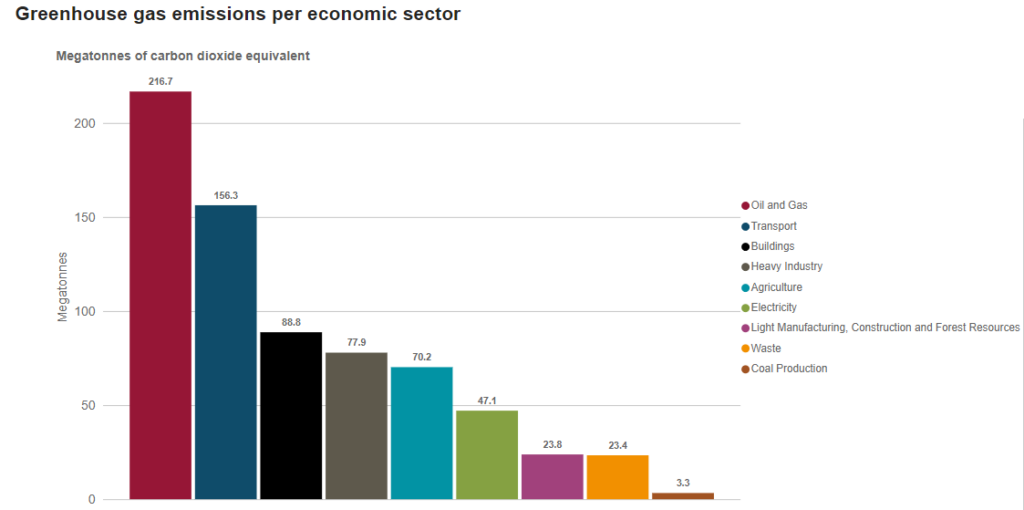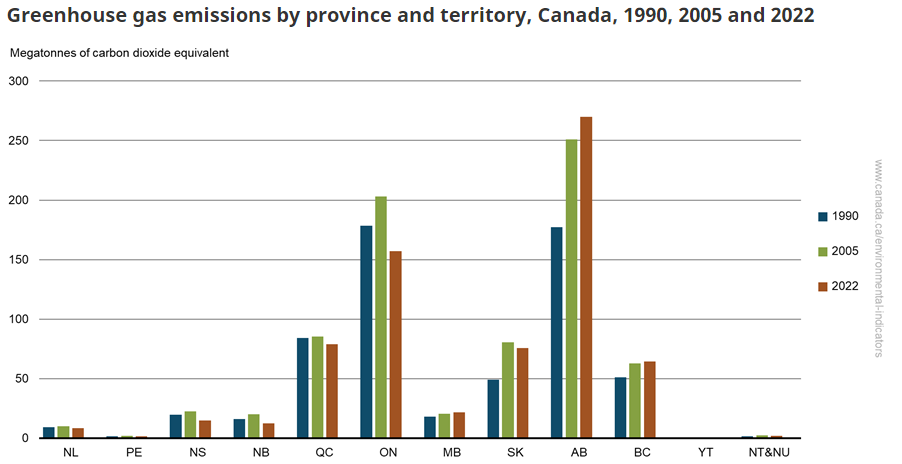Governments and regulators have made decarbonization a top priority many years. Recently, it has become a top priority for industrial consumers, businesses, and investors. Many businesses have ambitious net-zero goals to make sure they don’t violate their Paris Agreement pledges and go beyond the two-degree Celsius warming threshold.
Among the most significant contributors to emissions are industrial enterprises, which play a significant role in this endeavor. Some well-known examples are the steel and chemical industries, as well as the automotive, food processing, and heavy road transport industries. Accordingly, lowering carbon emissions might need significant investments in innovative technologies, modifications to business models, working together with other companies, and a whole new business plan.

Source: Government of Canada
Strategies to Institutional and Industrial Decarbonization
Decarbonization roadmaps encompass four technological foundations that are typically implemented to mitigate greenhouse gas (GHG) emissions.
Energy Efficiency: This foundational and cost-effective approach to reducing GHG emissions consists of strategies such as:
- System energy management involves optimizing energy performance through controls and schedules at the system level.
- Optimizing thermal heat from different manufacturing processes, boilers, and combined heat and power sources.
Industrial Electrification: New technologies which utilize low-carbon electricity from grid and onsite renewable sources will be vital for decarbonization. These efforts include.
- Electrifying process heat with induction, radiative heating, or advanced heat pumps.
- Switching thermal operations and heating systems to electrochemical ones.
The Use of Low-Carbon fuels, and energy Sources: Using low-carbon fuels and energy sources: these methods involve substituting fossil fuels with inexpensive alternatives. Include decarbonization efforts for
- Development of fuel-flexible processes.
- Integration of hydrogen fuels and feedstocks into industrial applications.
- The use of biofuels and bio feedstocks.
Carbon Capture, utilization, and Storage: This strategy incorporates multi components to capture CO2 from isolated sources and use or store the carbon to avoid release.
Engineering Feasibility Studies
Typically, an organization reviews and implements a roadmap after undertaking a comprehensive feasibility study. These studies were done to learn more about the pros and cons of all possible scenarios for different types of projects. This was done to gain internal knowledge and experience. In these studies, consultant engineers look at a group of buildings and their different design options and technologies. It will be compared to the “business as usual” scenario as well as lower-carbon paths that include installing energy-saving measures (ECMs) such as air source heat pumps, dual fuel hybrid heating/cooling systems, Geoexchange systems, all-electric systems, and waste water heat recovery.
The study will investigate capital cost, energy savings, GHG savings, lifecycle impacts, installation, maintenance, customer experience, and expectations. It also addresses KPIs to help organizations choose a decarbonization path, such as:
- Return On Investment (ROI).
- Simple Payback Period (SPB).
- Net Present Value (NPV).
- Cash Flow.
Stakeholders Engagement
To be successful, organizations ought to involve all staff members in decision-making, ensure sustainability part of their culture, and make sure every team member feels aligned with and responsible for decarbonization.
Grants and incentives to approach NetZero
Leaders in the Canadian business community are working to reduce GHG emissions to net-zero levels by developing new technologies, investing in their organizations, and transitioning their operations and internal policies. Businesses will be seeking for grants and loans from the government and banks. The Canadian government is offering numerous opportunities to obtain funds as part of its plan to cut GHG emissions to 40% to 45% below levels seen in 2005 by 2030 and to reach net-zero by 2050. Investment tax credits for Carbon Capture, Utilization, and Storage (CCUS) and provincial programs are examples of new initiatives.

Source: Government of Canada
Post Project implementation
Measurement & Verification (M&V) is the process of planning, measuring, collecting, and analyzing data to verify and report energy savings from energy savings opportunities. Energy projects usually require this process. M&V efforts must balance costs and accuracy: spending more money allows us to calculate savings more accurately, but it may not be worth it.

Benefits of M&V:
- Increase Energy Savings: Energy savings can be accurately measured to help facility owners and managers improve energy efficiency and achieve consistent savings.
- Enhance Financing for Efficiency Projects: An effective M&V Plan improves the credibility and transparency of energy-efficiency investment reports and forecasts.
- Improve Engineering Design and Facility Operations and Maintenance: Effective M&V processes help managers identify and address maintenance and operational issues, improving facility energy efficiency.
- Manage Energy Budgets: M&V techniques cope with facility-operating changes to properly budget and address variances.
- Enhance The Value of Emission-Reduction Credits: Emission reductions add value to energy-efficiency projects.
How Dillon Can Help
Dillon consistently prioritizes the development of Net-Zero pathways for institutional, governmental, and industrial clients. In this phase, Dillon’s team of skilled engineers and energy professionals thoroughly review the energy performance of existing buildings, conduct onsite energy audits, and identify a range of short- and long-term energy conservation measures, along with associated life cycle cost analyses. Our team possesses extensive expertise in identifying the most efficient methods for decarbonization of buildings. These methods encompass heat recovery, the utilization of renewable energy sources for heating and cooling, and the on-site generation of power from renewable sources.
In addition to that we offer other services such as:
- Preparing design and tender documents
- Funding application support.
- Construction administration
- Final commissioning
- M&V services
References:
- Doe Industrial Decarbonization Roadmap | Department of Energy. (n.d.). https://www.energy.gov/industrial-technologies/doe-industrial-decarbonization-roadmap
- Implementing decarbonization: What consumer companies should know. McKinsey & Company. (n.d.). https://www.mckinsey.com/capabilities/sustainability/our-insights/sustainability-blog/implementing-decarbonization-what-consumer-companies-should-know